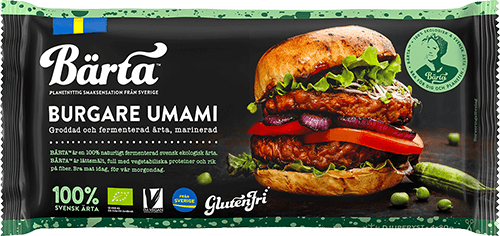

THE WORLD’S BEST PEA
Swedish-grown, organic, vegan, gluten free, without additives and insanely good!
THE WORLD’S BEST PEA
Swedish-grown, organic, vegan, gluten free, without additives and insanely good!
Bärta® is a 100% naturally sprouted and fermented Swedish organic pea.
Bärta is easy to digest, full of plant-based protein and high in fiber. great food today, for our tomorrow.
Where can I find Bärta?
Where can I find Bärta?
Bärta® is available on the Swedish market for both consumers and businesses.
SHOP IN STORE: You can find our products at ICA, Coop, Hemköp, Willys and City Gross as well as local stores like Bara Bra Mat, Fram ekolivs, Tant Gurka, Skärva ekobutik, Mossagården and more.
SHOP ONLINE: Mylla.se, Mossagården and online stores connected to ICA, Coop, Hemköp, Willys and City Gross,
WHOLE SALERS: Grönsakshallen Sorunda, Martin & Servera, Menigo foodservice
Are you interested in selling Bärta? Send an e-mail to hej@barta.se
Our favourite recipes
PLANET POSITIVE
PLANET POSITIVE
Bärta is planet positive! By this we mean that Bärta contributes to less carbon dioxide emissions and better ecosystem functioning – pea farming even gives back nourishment to our farmlands. To top it off, Bärta also has a number of health benefits for us humans.
PLANET POSITIVITY: HEALTH
PLANET POSITIVITY: HEALTH
BÄRTA IS A HEALTH CURE
Minimally processed whole foods where the end product is healthier than the original raw ingredient. Yes, we’re this cocky when we talk about Bärta. But what do we mean? Let’s take it from the beginning.
WHOLE foods
In whole foods the entire seed or vegetable is used. For example, in regular white flour the wheat has been stripped of it’s husk, but in whole-grain flour the wheat’s husk remains intact. A reduced risk for cancer and a stable blood sugar level are two main benefits of these slow carbohydrates.
Today, most vegetarian products on the market are based on a processed protein, where so-called protein isolates have been extracted from the legume. The pros: Since the extract contains highly concentrated protein, you can now answer the question: “But if you don’t eat meat, how do you get your protein, then?” The cons: Other healthy stuff and flavours are lost in the process. Also, certain studies show that eating too much protein can lead to poisonous substances developing in the intestinal tract. Thinking about how much protein we actually need may in other words be worth it.
ANTINUTRIENTS
It’s said that every cloud has a silver lining, but maybe it can also be said that every silver lining has a cloud. Anti-nutrients are substances in foods that binds to minerals, decreasing important nutrient absorption. Since anti-nutrients are mostly found in whole grain products, a paradox arises: Whole grains contain more nutrients but also anti-nutrients, hindering our bodies from absorbing all those healthy minerals. But don’t fret! The pros of whole grains weigh heavier than the cons. The same qualities that decrease mineral absorption also minimize cancer risk since minerals are bound in the intestinal tract, lessening harmful oxidative stress. For many, whole grains can be too tough to digest and harm the sensitive intestinal walls.
However, Bärta is both a whole grain product and gentle on the stomach. We make this possible by using traditional methods: sprouting and fermentation.
THE germinated PEA
When peas, beans and other seeds lie dormant they are protected by substances that break down when the seed is activated and starts to grow. This process is called germination, a long-used method to make nutrition from seeds attainable.
THE FERMENTED PEA
When peas are fermented we’re helped by microorganisms that change the original raw food ingredient into something a little more fun, yummier and healthier. When fermenting Bärta we use spores from the microfunghi Rhizopus. In Indonesia, this special mushroom has been used for centuries to turn soy beans into tempeh. The microorganisms eat hard-to-digest substances, breaking down antinutrients and leaving only the good stuff through this fermentation process. They also break down the actual flavour substances into smaller particles, resulting in fermented products tasting more and giving unique flavour sensations.
Is Bärta a type of tempeh? Yes and no. Yes, because our process is based on the same fermentation method. No, because regular tempeh isn’t germinated and is made from hulled soybeans. Bärta is made from whole grain peas, which gives a different flavour and texture.
Fermented foods are very trendy at the moment because of the good bacteria they contain. However, Bärta should not be consumed raw and bacteria die when heated. In other words, eating Bärta won’t provide you with good bacteria. On the other hand you get fibres and prebiotics – which is what good, probiotic bacteria live on. In fact, prebiotics play a bigger role for a healthy gut flora since it’s more important for good bacteria to have prebiotics to eat than just adding probiotic bacteria. So without prebiotics, no probiotics!
PLANET POSITIVITY: CLIMATE
PLANET POSITIVITY: CLIMATE
BÄRTA HAS A SMALL CARBON FOOTPRINT AND POSITIVE ENVIRONMENTAL QUALITIES
Our starting point when developing Bärta is to create a food product with very low climate footprint that will be enough to go around for all people on earth – today as well as in a millenium.
If we are to reach international and Swedish national climate goals a shift is needed, where more people choose plant-based protein instead of meat. To make this happen new types of food are needed, food with low carbon emissions that are healthy and insanely good.
Bärta has very low carbon emission between that lie between 0.3 and 0.8 Co2e/kilo product. The average for beef is 26 and for meat substitute in general the number is 3.
Pea farming even has the fantastic ability to bind nitrogen from the air into the ground, leading to better soil quality and a decreased fertilization need.
PLANET POSITIVITY: ECOLOGY
PLANET POSITIVITY: ECOLOGY
For us, it’s not enough to be climate-smart – we aim to be planet positive all the way. Therefore, we take care of ecosystems and strive for a circular economy.
ORGANIC
The key difference between organic and conventional farming is that artificial fertilizers and chemical pesticides are forbidden in organic farming. There are many types of organic certifications with varying rules, but the basics are always the same – no poisons, no artificial fertilizer.
PESTICIDES
Now we don’t think just one pesticide-sprayed tomato will kill you – the trace amount of poison left is too small by the time the tomato lands on your plate. However, maybe the person who grew the tomato will die due to pesticide exposure. We stand for poison-free agriculture because we don’t want to contribute to increasing poison levels in farmlands, fields, lakes and seas, harming flora and fauna (including humans) for a long time to come. Not so long ago, the pesticide DDT was seen as humanity’s saviour and was even given the Nobel Prize. Then marine biologist and author Rachel Carson sounded the alarm that DDT caused birds, as well as people, to die in her groundbreaking 1962 book “Silent Spring”. Today, the herbicide glyphosate is on a similar path. We therefore follow a carefulness principle – it’s best to really be sure that something isn’t harmful before it’s implemented on a large scale.
ARTIFICIAL FERTILISER
Artificial fertiliser is manufactured through an industrial process. In itself this isn’t wrong, but the problem is that the process consumes much, often finite fossil-fueled, energy. We believe in a more “from dust to dust”-approach, where nutrients and energy required for growth is naturally broken down, recycled and reused for coming generations of all life on earth. That’s how a healthy ecosystem works and can feed it’s inhabitants year after year.
FAQ
FAQ
Q: Where and how is Bärta made?
A: In our local Karlshamn production kitchen. Karlshamn is our hometown and for us making Bärta is still a craft where our different products are given lots of tender loving care. First, we sprout and cook the split peas. Then we mix them with starter culture and let them ferment in a warm room for a few days. After that, we marinate and fry the peas for our “Burger Umami” patties and “Bitar Chili & Lime” chunks. The bigger, plain piece for our “Helbit Rå & Naturell” is frozen directly following fermentation.
Q: What is fermentation?
A: When we ferment our peas we’re helped by microorganisms that change the original raw food material into something a little more fun, yummier and healthier.
Q: Does Bärta contain gluten?
A: Bärta is gluten free.











